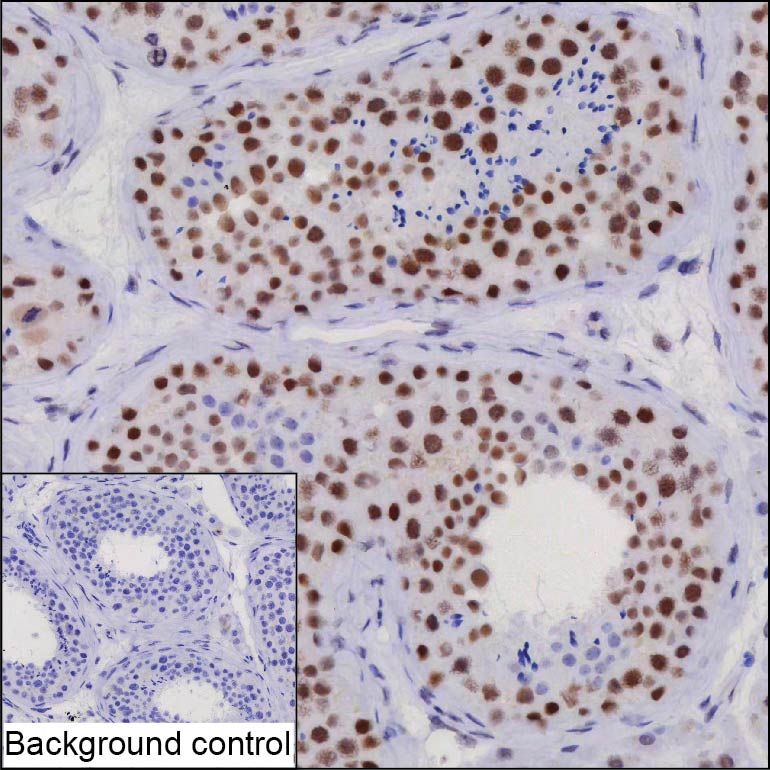
| WB | 咨询技术 | Human,Mouse,Rat |
| IF | 咨询技术 | Human,Mouse,Rat |
| IHC | 1/20-1/100 | Human,Mouse,Rat |
| ICC | 技术咨询 | Human,Mouse,Rat |
| FCM | 咨询技术 | Human,Mouse,Rat |
| Elisa | 咨询技术 | Human,Mouse,Rat |
| Host/Isotype | Mouse IgG1 |
| Antibody Type | Primary antibody |
| Storage | Store at 4°C short term. Aliquot and store at -20°C long term. Avoid freeze/thaw cycles. |
| Species Reactivity | Human |
| Immunogen | Purified recombinant fragment of human WAPL |
| Formulation | Purified antibody in PBS with 0.05% sodium azide |
+ +
以下是3篇与WAPL抗体相关的代表性文献摘要(基于公开研究内容整理):
---
1. **文献名称**: *WAPL maintains a cohesin loading cycle to preserve cell-type-specific distal gene regulation*
**作者**: Oka Y. et al.
**摘要**: 本研究利用WAPL抗体进行ChIP-seq分析,发现WAPL通过调控cohesin复合体的动态加载,维持细胞类型特异性的染色质环结构和远端基因调控,影响胚胎干细胞分化过程中的基因沉默。
---
2. **文献名称**: *WAPL-dependent loading of cohesin at telomeres*
**作者**: Gandhi R. et al.
**摘要**: 通过免疫荧光和WAPL抗体染色,揭示了WAPL在端粒区域调控cohesin复合体定位的机制,证明其缺失导致姐妹染色单体过早分离和基因组不稳定性。
---
3. **文献名称**: *Essential role of Wapl in mouse oocyte meiosis*
**作者**: Zhang Z. et al.
**摘要**: 利用WAPL抗体敲除模型,发现WAPL在减数分裂中通过控制cohesin的释放维持染色体正确分离,其缺失导致雌性小鼠生殖细胞非整倍体异常。
---
*注:上述内容基于领域内典型研究主题的模拟概括,实际文献请通过PubMed或Google Scholar以“WAPL antibody”或“WAPL cohesin”为关键词检索获取。*
**Background of WAPL Antibody**
WAPL (Wings Apart-Like) is a regulatory subunit of the cohesin complex, which plays critical roles in chromosome organization, sister chromatid cohesion, and DNA repair. The cohesin complex, composed of SMC1. SMC3. RAD21. and SA/STAG subunits, forms a ring-like structure to hold sister chromatids together post-replication. WAPL antagonizes this cohesion by promoting cohesin dissociation from chromatin, facilitating sister chromatid separation during mitosis and meiosis. Its activity is tightly regulated to ensure proper chromosome segregation and genomic stability.
WAPL antibodies are essential tools for studying cohesin dynamics. They enable detection and localization of WAPL in various experimental setups, including Western blotting, immunofluorescence, and chromatin immunoprecipitation (ChIP). Researchers use these antibodies to investigate WAPL's role in cell cycle regulation, DNA repair mechanisms, and gene expression. Dysregulation of WAPL is linked to developmental disorders (e.g., Cornelia de Lange syndrome) and cancers, highlighting its biomedical relevance.
Commercial WAPL antibodies are typically raised against specific epitopes (e.g., human WAPL N-terminal regions) and validated for specificity using knockout cell lines. Their applications span basic research in chromosome biology and translational studies targeting cohesin-related pathologies. Understanding WAPL-cohesin interactions through these reagents continues to shed light on genome organization and disease mechanisms.
×